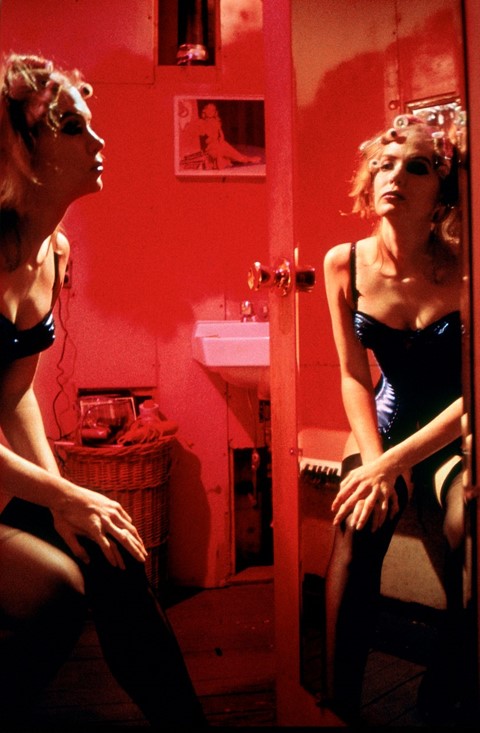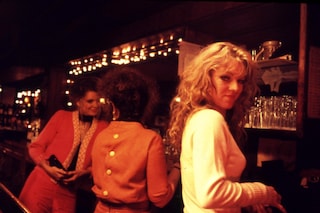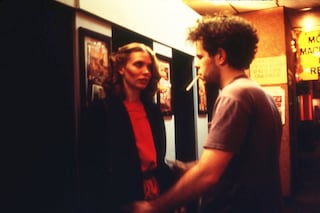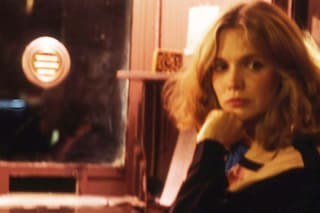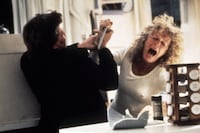Featuring a cameo from Nan Goldin, the gender-swapped neo-noir showcases unrestrained female sexuality – here, its director Bette Gordon speaks to Dazed about the film’s backstory and feminist legacy 40 years after its release
Long predating Pornhub and OnlyFans, New York City had the Variety: a 1940s-style cinema showing old-school adult films within its auditorium and coin-activated private booths – its neon marquee marking an escape for voyeuristic pleasure tucked among New York’s very public Lower East Side. When she first moved to New York in 1980, American filmmaker and director Bette Gordon developed a quick fascination with the theatre, admiring the men shouting “PORN! LIVE GIRLS! COME IN!” out front and slipping into the auditorium to catch glimpses of the films – a similar captivation held by the main character in her 1983 film, aptly titled Variety.
The film – which was first met by a critical response when it premiered at Sundance in the 80s and has now grown a cult following for its unfaltering portrayal of female sexuality – follows aspiring writer Christine [Sandy McLeod] as she takes up a job selling tickets at the porn cinema to make rent. Quickly entranced by the cinema, Christine begins stalking a man she met there – flipping standard neo-noir gender roles by following the man to a baseball game, sex shops, and a fish market.
As the writer’s obsession grows, so does the pleasure she finds through her own sexuality. Off-duty from The Variety ticket booth – after reciting sexual fantasies to her disinterested boyfriend, studying pornographic magazines while breaking into her fixation’s hotel room, and dressing up in pigtails and lingerie just to stare at herself in the mirror – Christine finds herself articulating her desires out loud by inviting the object of her voyeurism to meet her at a street corner late at night, an invitation left pending by Gordon.
“[It’s] a film about the pleasure of looking,” the director tells Dazed, leaving any hints to the film’s inconclusive climax unanswered. Today, it’s 40 years since the film first premiered, and Gordon has flown to London to kick off a series of Variety screenings at cinemas and film festivals across the UK. Rewind back to the 80s, however, and she was piecing together an early, 25-minute draft of the film on a super-eight camera with a $75 budget – money granted to her by New York City non-profit organisation Artists Space’s Emergency Fund to help combat a sudden drop in arts funding.

“[Artists Space] said, ‘Invite filmmakers you want,’ and they would give them $75, and [with that money] you had to make a film, and we had a date by which it had to be finished,” explains Gordon. “And, there was The Variety theatre. I was so clear about the fact that I love to watch, I love to look – and voyeurism is something that's a part of our culture anyway – so I got closer and closer to the cinema, and I was in love with it.”
Armed with her endowment and drawing inspiration from Dorothy Arzner’s 1940s film Dance Girl Dance – which follows a ballet dancer-turned-stripper who disrupts her burlesque club’s status quo by shouting at male audience members [Gordon notes that Arzner was repeatedly excluded from film history books, despite her significant contributions to the industry] – Gordon landed on the idea of focusing the film on a social disruptor via Christine’s unrestrained sexuality.
“I like the idea of taking something that exists and turning it around and looking at it from another point of view” - Bette Gordon
“I like the idea of taking something that exists and turning it around and looking at it from another point of view,” says Gordon, who herself had been thrown out of typically male-dominated spaces like porn shops for being a woman – experiences that directly inspired Christine’s sex-driven stalking. “That idea of reinhabiting and re-controlling the narrative for me was that if [Christine] could turn the idea of being followed around, then she becomes the follower.”
Extending her Emergency project into a full-length feature due to additional funding [you can watch the original short film, titled Anybody’s Woman, here], the director packed in an additional 75 minutes exploring the gender-swapped dynamic with a screenplay penned by experimental, feminist writer Kathy Acker. Included within Variety – providing a glimpse inside Christine’s all-consuming sexual awakening – the writer lays on her bed to listen to a meditation tape, and aroused by the therapist’s voice, she fantasises a long montage of different men shaking hands.
“[The tape] was so sexual!” Gordon says with a laugh, noting that it was the same meditation tape that she had tried around that time. Prompted by the tape’s guiding voice, Christine’s dreamed-up handshakes showcase a masculine equivalent to women’s role in porn under the male gaze. “I’ve always been interested in handshakes,” the director continues. “They’re a silent language, a language with no words. Women shake hands all the time, but it’s a male image, and it’s an image I’m always watching.”
Meanwhile – multiple times throughout the film – Christine expresses her own sexual fantasies out loud. “A woman reaches up and unties the neck strap of her halter. Half-turning, she steps out of her panties. She licks her lips and rubs her nipple until it’s stiff,” recounts Christine, entering a trance-like state before her boyfriend gets up to leave.
According to Gordon, this disregard of Christine’s erotic expression mirrored men’s expectations of women’s sexuality at the time. “In my day, men claimed that they wanted women who were open,” she says. “When it comes down to it, though, they also had a kind of fear. Men weren’t used to women speaking that language, they’re usually spoken [to].”
In resistance to this, Gordon gave Christine active speaking to express her desires and pleasures however she pleased, without any self-inflicted shame – a risk heavily motivated by New York City’s anti-establishment art scene in the 70s and 80s. “What people were doing then was a kind of exploration for its own sake,” she explains. “We were anti-everything, and we wanted to reinvent art forms with exploration and celebration and curiosity.”
“We were anti-everything, and we wanted to reinvent art forms with exploration and celebration and curiosity” - Bette Gordon
With countless culture-shifting projects spanning music, art, photography, and film dropping each week at bars favoured by Gordon’s artistic community, Gordon felt encouraged to construct her own radical, label-free, and extremely sex-forward plot-lines without any pressure from agents, brands, or internet culture. “The smallness of what we wanted to do was a blessing,” says Gordon.
Leaning into her creative circles, the filmmaker also recruited long-time friend, photographer, and activist Nan Goldin to take part in the project, lensing a series of behind-the-scenes images and playing the role of a bartender at the Tin Pan Alley – a bar frequented by Christine [and often visited by Gordon and her friends IRL]. At the bar, Christine leans to Nan’s character for support, joining with her and other friends for candid conversations about sex work and male desire – moments that express the film’s sharp documentation of the nuance within women’s real-life sexual experiences.
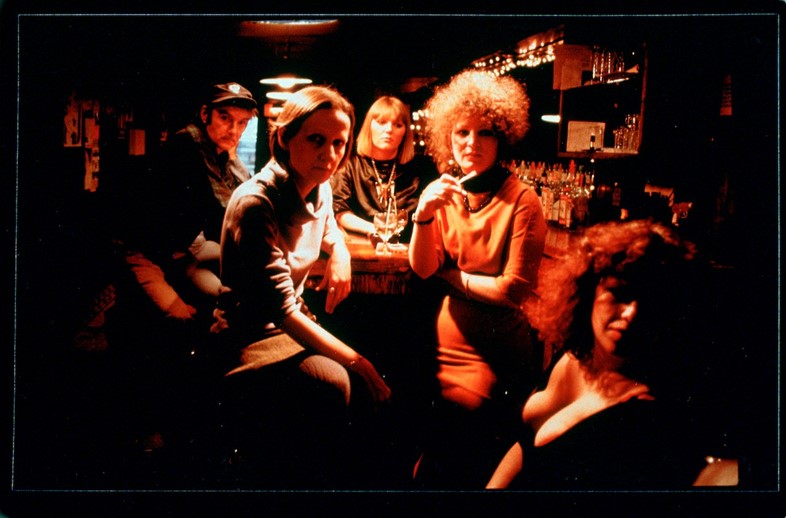
Interspersed between quick cuts of dialogue, however, Gordon reveals long, brooding shots of New York City – allowing for city landscapes, markets, and casinos to take on their own characters within the project and deepening tension for the viewers amid Christine’s journey. “What is cinema, really? It plays with time and space, it’s not just story,” declares the director, who – after Christine confesses her actions to the man she’s stalking and instructs him to meet up with her on a street corner– closes the film on a minute-long shot of the dark, empty street.
With Christine’s fate up to interpretation – a choice which led some early viewers to lambast the film as underwritten – the narrative lands in the viewers’ hands, withholding a mainstream climax by allowing each onlooker to decide the writer’s fate. “As a filmmaker, I lead you down a road and that road is for you to follow and engage with,” Gordon says with a smile.
So, what is the answer? “In life, the questions are more important than the answers,” the director retorts – providing little insight into Christine’s storyline, but perhaps encouraging a future generation to engage with unanswered, risk-taking ideas as she did after stumbling upon The Variety.
Find Variety’s upcoming showtimes here, and view Nan Goldin’s photography shot behind the scenes of the film in the gallery above.
Join Dazed Club and be part of our world! You get exclusive access to events, parties, festivals and our editors, as well as a free subscription to Dazed for a year. Join for £5/month today.
